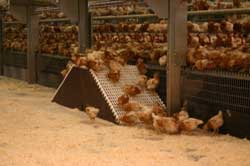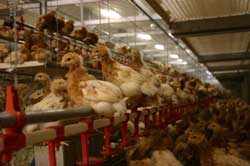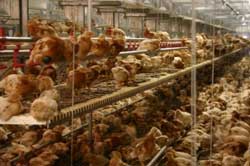



Rearing Layers for a Modern Production Environment
Editor of ThePoultrySite, Jackie Linden, visited one farmer in the Netherlands who is helping to prepare pullets for a healthy and productive life in multiple-level aviaries.In Europe, there is a growing demand for hens that have been reared in an aviary system. In the first place, this demand comes from the increased number of hens in an aviary systems in many European countries, due to the EU cage ban in 2012. Furthermore, farmers with floor and flat-deck systems are also asking for these birds, as they just seem to be stronger and perform better in the later production stage.



Pieter Maris is an example of a farmer dedicated to prepare strong pullets for modern layer housing systems on his farm in Dinteloord in the Dutch province of North Brabant. In addition to his arable area growing potatoes, beans and cereals, Mr Maris has two houses in which he rears layer pullets – one with 40,000 birds and the other with 65,000 birds.
At the time of the visit, he had eight-week old Lohmann Brown birds in both houses, which are equipped with the Jump Start rearing system from Vencomatic. The birds are grown under contract for the Dutch layer hatchery, Verbeek.
Level Training Principle
The secret behind the success of the Jump Start system is the integrated level training principle. The idea is simple: chicks learn to jump because the height difference between the feeding and the drinking lines is gradually increased. The feeding lines are placed on the lower slat area, while the drinking lines are place above a winchable slat, which moves up together with the drinking line. By starting with a small height difference that is gradually increased, all birds learn to jump.
Preparing Pullets for an Active Life
"The goal of rearing pullets should be to prepare them in the best possible way for the production cycle," Wilbert van de Heuvel, rearing manager from Verbeek's hatchery, explained. "Therefore the rearing house should be adapted to the production environment. These birds will be put in an aviary system with slats, perches, chain feeding lines and nipple drinkers. It would be wrong to rear them on the floor, without slats and perches and with feed pans instead of chain feeders."
"These birds learn to rest on a slat, jump to a perch and find water on a higher level. This is exactly what they should learn for a successful start in the production period in a multi-tiered aviary system," Mr Maris added. "I was surprised at first to see how active and adventurous the young birds are, exploring the whole area and moving through the system, between the different floor levels and perches from a young age."
The birds enter at day-old and are confined on one level with feed and nipple drinkers. The sides of the system are vertical for the first few days to allow the birds to become accustomed to the system, particularly the location of the nipple drinkers and feeders. After the birds have become used to the system for about two weeks, the feed and water lines are gradually raised, and the side walls are lowered to allow the birds to move freely around the house.
Measures to Minimise Feather Pecking
At 19 days of age, the birds are beak-trimmed. Mr Maris explained that this is done to help prevent feather pecking when the birds are older. Beak trimming at this stage is common practice in the Netherlands, in order to minimise feather pecking in the production flock.



As a further measure to deter feather pecking, handfuls of dried lucerne are placed on the floor periodically to occupy the birds. It is known that often, feather pecking problems in mature hens can be traced back to the rearing phase, and Mr Maris is determined to do all he can to stop his birds from getting into bad habits.
At four weeks of age, the platforms start to be raised so the young pullets gradually become used to moving around the house, while the lights start to be dimmed to keep the birds as calm as possible.
Maximising Efficiency in Labour
At 14 weeks, the birds are vaccinated. The house is emptied three to four weeks later, when the pullets are 17 to 18 weeks old. The Jump Start system helps to improve the efficiency of labour during vaccination and catching the birds. All feeders and drinkers are winched up and the system forms a tunnel, which makes it easy to catch the birds.
This is the fourth flock in the house, explained Mr Maris, adding that mortality has been typically just three to four per cent. He commented that the house is generally easy to manage – an important factor as he does not have employees on the farm apart from his father and his wife, who help out in busy arable times. However, additional help is brought in for the vaccinations and for cleaning the houses between flocks.
There is a minimum three-week period required between flocks – including three days to remove the manure – and three or four additional workers are used for cleaning.
Mr Maris clearly puts a great deal of effort into rearing pullets prepared for a healthy, active and productive future life.
Video showcase
To see a video showcase of the Jump Start system at Mr Maris's farm, you can visit www.vencomatic.net.August 2009








